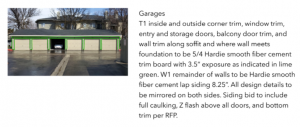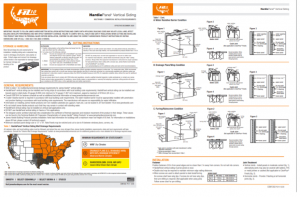Spring is just around the corner and ownership groups are starting to take action on those long overdue construction capital improvement projects which means more RFP’s (Request for Proposals) for you to create or manage. By now you have probably created a variety of templates or perhaps even worked with a company specializing in the process all together. And the one thing that is consistent no matter who created the template and final document - they are never the same. So, how do you know what details to include for your next project? We are going to outline the essential sections of an exterior construction RFP to ensure that your project requirements are acutely understood and that the responding parties are submitting detailed, clear, and complete proposals. If you’re working on an exterior remodeling project including roofing, siding, windows and doors, Endeavor Exteriors will even work together with you to write your RFP. To get you started, we are going to outline how to define the scope of project, essential sections to create a detailed RFP and highlight the Endeavor RFP process. First, Remember the Second RFQ (Request for Qualifications) Before we jump into how to write the RFP, remember to outline what qualifications you are expecting out of your winning contractor company, also known as the Request for Qualifications (RFQ). How do you do that? We recommend asking all contractors to provide a Statement of Qualifications (SOQ), a resume of sorts, providing you with a company overview, services provided, and relevant experience. You probably already have a list of contractors to consider, a SOQ can help you quickly explore additional companies to include. Then, if you haven’t already looked into using third parties as part of your RFQ, consider Real Page (Formerly Compliance Depot) and Net Vendor who are vendor credentialing services that conduct background checks. You can be confident the contracted company holds insurance and is in good financial standing. Depending on the company, you can screen up to 40 qualifications through their services.  Additionally, when specifying manufacturer products, take the guessing game out and provide a link or reference to the manufacturer, material of choice and installation process as recommended by the manufacturer. Including these materials, especially the expected installation process not only provides true scope of work in detail but allows contractors to recognize if they can or cannot complete the job as expected. James Hardie does a great job providing installation requirements on their website for all their products. Doing the work ahead of time and tracking down material and installation references can prevent back and forth during the RFP submission process, ultimately eliminating extra phone calls or emails between you and the contractor.
Additionally, when specifying manufacturer products, take the guessing game out and provide a link or reference to the manufacturer, material of choice and installation process as recommended by the manufacturer. Including these materials, especially the expected installation process not only provides true scope of work in detail but allows contractors to recognize if they can or cannot complete the job as expected. James Hardie does a great job providing installation requirements on their website for all their products. Doing the work ahead of time and tracking down material and installation references can prevent back and forth during the RFP submission process, ultimately eliminating extra phone calls or emails between you and the contractor. 
How to Write a Detailed RFP
Just as important as what to do, let’s start with what not to do. Missing information in your RFP can result in unclear and varying bids from your contractors causing confusion. The RFP is crucial to a complete and quality construction project. When you have three contractors responding and two come back around the same price while the other much cheaper (or more expensive), it’s likely there was confusion in the RFP that could have been avoided with better planning and detail. It’s common for more expensive bids to come in containing more detail where less expensive ones may have missed some important areas of the project. Requirements of Proposal (Setting Expectations) This section outlines what and how you want your RFP to be received from the responding contractors. Provide a detailed, bulleted list so nothing gets missed and set the standard for what you expect. Some examples include:- Line item pricing
- Alternative product recommendations
- Measurements for each component
- Lump-sum cost of the entire project
- Warranty terms
- Deadlines for any necessary RFIs, Proposal Due Dates
- Location
- What is the main problem your contractor needs to solve?
- What is the end goal of your project? (increase value, update look and feel enhance curb appeal, repair storm damage, etc.)
- What steps have you already taken to address the problem or opportunity?
- What is working and not working?
- At this point, how do you envision a solution?
- Do you have pictures related to the problem(s) to share?
- Are there specific products or manufacturers you want to use?
- What is the timeline?
- Remove existing siding on all residential apartment buildings, garages, mail kiosks and clubhouse.
- Remove and replace all windows, and sliding glass doors per specs below or equivalent.
- Install new [Manufacturer name and product] house wrap per manufactures specifications and as approved by owners
- Place drop clothes to protect entire area where work is being done.
- Cut caulking from interior to avoid damage to existing paint and drywall.
- Seal window using plastic sheeting and masking tape from the inside forming containment barriers if any drywall needs to be cut back.
- After existing window has been removed, thoroughly vacuum all dust and debris from window frame and surrounding area.
 Additionally, when specifying manufacturer products, take the guessing game out and provide a link or reference to the manufacturer, material of choice and installation process as recommended by the manufacturer. Including these materials, especially the expected installation process not only provides true scope of work in detail but allows contractors to recognize if they can or cannot complete the job as expected. James Hardie does a great job providing installation requirements on their website for all their products. Doing the work ahead of time and tracking down material and installation references can prevent back and forth during the RFP submission process, ultimately eliminating extra phone calls or emails between you and the contractor.
Additionally, when specifying manufacturer products, take the guessing game out and provide a link or reference to the manufacturer, material of choice and installation process as recommended by the manufacturer. Including these materials, especially the expected installation process not only provides true scope of work in detail but allows contractors to recognize if they can or cannot complete the job as expected. James Hardie does a great job providing installation requirements on their website for all their products. Doing the work ahead of time and tracking down material and installation references can prevent back and forth during the RFP submission process, ultimately eliminating extra phone calls or emails between you and the contractor. 
Evaluation Process
How are you going to evaluate the submitted proposals? We know cost is often the primary consideration, however other factors can help you determine who will be awarded the project. For example, use a simple rating system to help analyze responsiveness to project requirements, clarity of proposal and expertise. Additional factors to evaluate may include:- Relevant past performance and experience (Request previous customers to contact for references)
- Ability to work and obtain necessary permits at the job location (Location specific to contractor)
- Errors found within the proposal (EX: 0-5 errors gets 3 points, 5-10 errors gets 2 points and 10+ errors gets 1 point)
Working with Endeavor Exteriors through your RFP Process
To start, Endeavor Exteriors will write your RFP! We will work with you to define your requirements and scope of work including annotated images and even measurements to ensure accurate quotes are received. Contact us directly if you would like to work together to create a detailed RFP. When Endeavor Exteriors receives an RFP, we will reach out to have a discovery call and ensure we understand all your requirements, scope of work, evaluation process and to verify deadlines. We will schedule an inspection on this call to come take property pictures and measurements. We use specific software and technology that enhances the measurement process and reduces error to create a detailed scope of work. After inspection, we will follow up with a call to review our findings, send you the report to come to an agreement on scope of work based on our findings and discussions. Our team creates an estimate and has another call with your team to review preliminary numbers before we submit a final proposal. For HOA’s specifically, we will also have a sales presentation with visuals of dashboards, reports, past project highlights. We love presentations so even if you are not an HOA, we would love the opportunity to present. It is our goal to add value every step of the way. Do you need help writing your construction remodeling RFP? Contact us today! We would be happy to help.Tags
Subscribe to Endeavor Exteriors's Blog



Comments